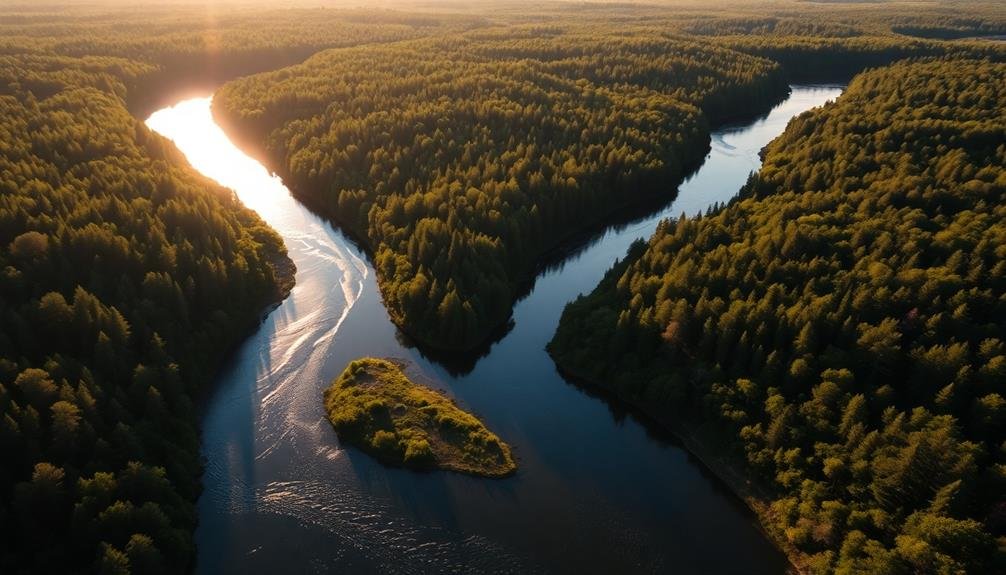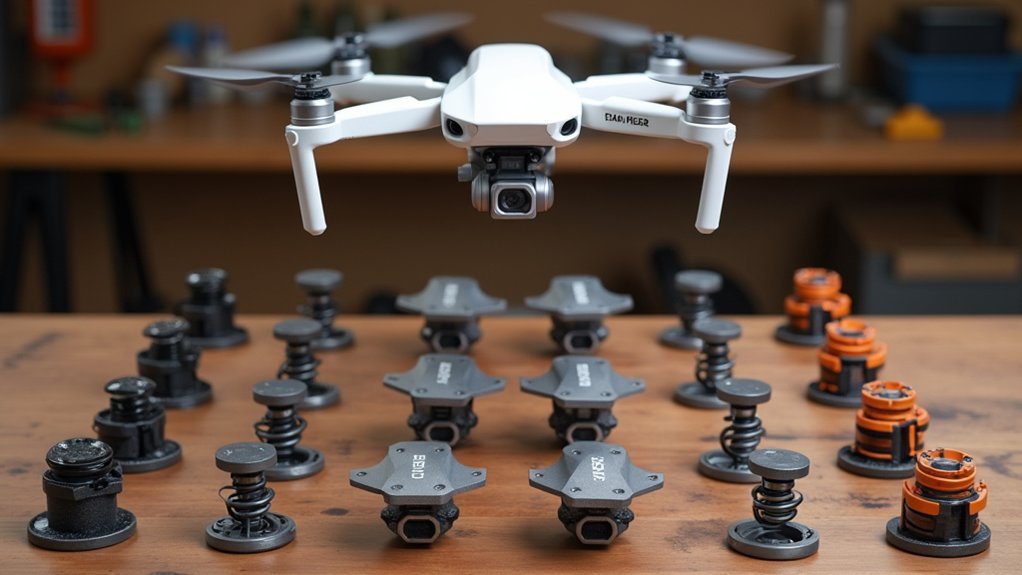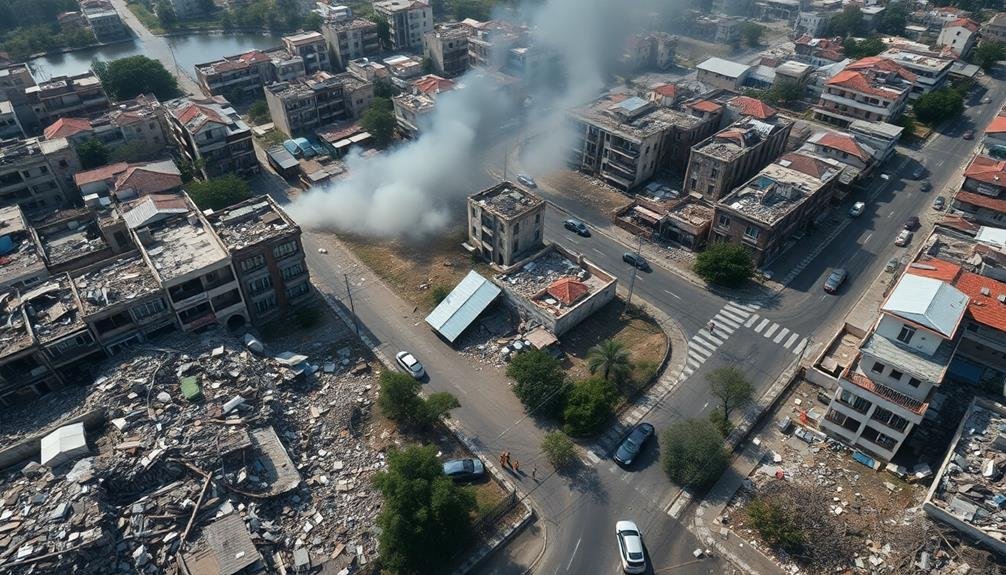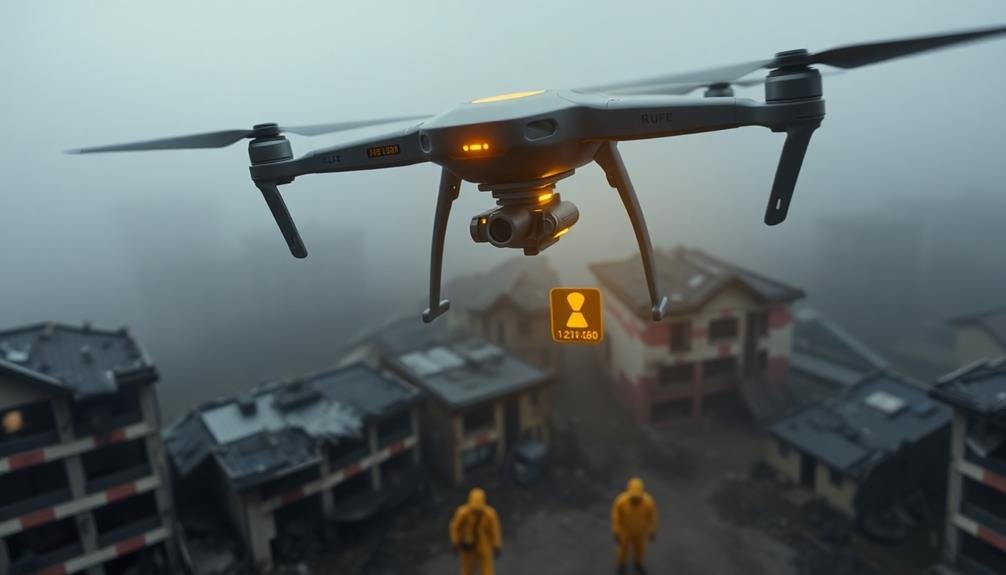To evoke emotion in aerial photography, you'll want to master seven powerful techniques. Play with light and shadow to create depth and drama. Capture unexpected patterns and textures that reveal hidden beauty. Frame natural leading lines to guide the viewer's eye. Emphasize scale and perspective to showcase the grandeur of landscapes. Incorporate human elements strategically to add relatability and context. Leverage seasonal changes to highlight nature's transformations. Experiment with weather conditions to add mood and atmosphere. By combining these techniques, you'll elevate your aerial shots from mere images to enthralling stories that stir the soul. The sky's the limit for what you can achieve with these methods.
Key Takeaways
- Manipulate light and weather conditions to create dramatic contrasts, ethereal atmospheres, and mood-enhancing effects.
- Highlight patterns, textures, and leading lines to guide the viewer's eye and create visual interest.
- Emphasize scale and perspective by juxtaposing large and small elements or including human elements for relatability.
- Capture seasonal changes to showcase nature's transformations and evoke different emotions throughout the year.
- Experiment with various altitudes and angles to transform familiar scenes into abstract patterns or unique perspectives.
Play With Light and Shadow

Light and shadow are the heart and soul of aerial photography. They're your most powerful tools for creating depth, drama, and emotion in your shots. When you're up in the air, you'll notice how sunlight interacts with the landscape below, casting long shadows and highlighting textures you might miss from the ground.
To make the most of light and shadow, time your flights carefully. The golden hours just after sunrise and before sunset offer warm, soft light that can transform ordinary scenes into breathtaking vistas.
During midday, harsh sunlight creates strong contrasts, which you can use to emphasize geometric patterns in urban areas or agricultural fields.
Don't shy away from overcast days; diffused light can reveal subtle details and create a moody atmosphere. In low-light conditions, experiment with longer exposures to capture the movement of clouds or water.
When shooting cityscapes at night, you'll find that artificial lights create a dazzling display of color and form.
Remember to adjust your camera settings to account for changing light conditions. Use your drone's gimbal to explore different angles, finding the perfect balance between light and shadow to tell your story from above.
Capture Unexpected Patterns and Textures

When capturing aerial shots, you'll often spot unexpected patterns and textures that aren't visible from the ground.
Look for geometric shapes in urban landscapes, such as the grid-like layout of city streets or the symmetry of building rooftops.
In natural settings, you can highlight textures like the ripples of sand dunes, the intricate patterns of river deltas, or the varied hues of forest canopies.
Emphasize Geometric Shapes
Geometric shapes and patterns emerge as hidden treasures when viewed from above. As an aerial photographer, you'll want to capitalize on these unique perspectives to create visually striking images. Look for symmetry, repetition, and contrast in both natural and man-made environments. Crop your shots to emphasize these shapes, drawing the viewer's eye to the most intriguing elements.
You'll find that urban landscapes often provide a wealth of geometric possibilities. Seek out grid-like street patterns, circular roundabouts, and the angular silhouettes of skyscrapers.
In rural areas, focus on the clean lines of agricultural fields, the curves of meandering rivers, or the fractal-like patterns of forested hillsides.
Don't forget to experiment with light and shadow to enhance geometric forms. Early morning or late afternoon sun can cast long shadows, creating additional shapes and adding depth to your compositions.
Use your drone's altitude and positioning to your advantage, adjusting your angle to maximize the impact of these shapes. Remember, the goal is to transform familiar scenes into abstract, enchanting images that challenge the viewer's perception and evoke an emotional response.
Highlight Natural Textures
From the sky, Earth's natural landscapes reveal a tapestry of unexpected textures and patterns. As an aerial photographer, you'll find yourself captivated by the intricate details that become visible from above. To highlight these natural textures effectively, focus on capturing areas with diverse geological features or varied vegetation.
Look for:
- Rippling sand dunes in deserts
- Fractured ice sheets in polar regions
- Meandering river systems and their deltas
- Lush forest canopies with varying shades and textures
When shooting, adjust your camera settings to emphasize texture. Use a higher shutter speed to freeze details and a smaller aperture for greater depth of field.
Play with light and shadows to accentuate the three-dimensional quality of the landscape. Early morning or late afternoon light can create long shadows that emphasize texture and depth.
Post-processing can further enhance natural textures. Experiment with contrast, clarity, and sharpening tools to bring out subtle details. Don't overdo it, though – aim for a natural look that doesn't appear artificially enhanced.
Frame Natural Leading Lines

Natural leading lines serve as powerful compositional tools in aerial photography. They guide the viewer's eye through the image, creating a sense of depth and direction.
When you're capturing aerial shots, look for rivers, roads, coastlines, or mountain ridges that form natural lines in the landscape. These elements can lead the viewer's gaze to your main subject or create a sense of journey within the frame.
To effectively use leading lines, position your drone to align these natural elements with your composition. You'll want to experiment with different angles and altitudes to find the most impactful arrangement.
Try placing the lines diagonally across the frame for a dynamic feel, or use them to create symmetry by centering them in your shot. Don't forget to reflect on the direction of light, as shadows can enhance the appearance of these lines.
Remember that leading lines don't always have to be straight. Curved paths, meandering rivers, or winding roads can add a sense of flow and rhythm to your aerial photographs.
Emphasize Scale and Perspective

One of the most compelling aspects of aerial photography is its ability to reveal the true scale and perspective of landscapes and structures. As an aerial photographer, you'll want to capitalize on this unique vantage point to create striking images that leave viewers in awe.
To emphasize scale and perspective in your aerial shots, consider these techniques:
- Juxtapose large and small elements within the frame
- Include recognizable objects for size reference
- Shoot from various altitudes to alter perception
- Experiment with different angles and compositions
By incorporating these methods, you'll create images that challenge viewers' perceptions and evoke a sense of wonder. For instance, capturing a vast desert landscape with a tiny caravan of vehicles traversing it can effectively convey the immensity of the environment.
Don't shy away from using extreme angles or unusual perspectives. Shooting straight down on a cityscape can transform familiar streets into abstract patterns, while a low-altitude oblique shot of a mountain range can accentuate its towering peaks.
Incorporate Human Elements Strategically

While emphasizing scale and perspective can create stunning aerial images, strategically incorporating human elements adds depth and relatability to your shots. You'll want to carefully place people or human-made structures within your frame to provide context and evoke emotional connections.
Consider including:
| Element | Purpose |
|---|---|
| People | Scale reference |
| Vehicles | Movement and life |
| Buildings | Cultural context |
| Roads | Patterns and connectivity |
When adding human elements, you'll need to balance their presence with the overall landscape. Don't let them overpower the scene, but rather use them to enhance the story you're telling. You can achieve this by positioning people or objects near the edges of the frame or using them as leading lines.
Remember that even small human elements can have a big impact in aerial photography. A lone hiker on a mountain trail or a single boat in a vast ocean can create a powerful sense of isolation or adventure. By thoughtfully incorporating these elements, you'll create more engaging and emotionally resonant aerial photographs that connect with your audience on a deeper level.
Leverage Seasonal Changes

You'll find endless opportunities for compelling aerial shots by embracing nature's ever-changing palette throughout the year.
Capture the fiery reds and golds of autumn foliage, or showcase the stark, minimalist beauty of snow-covered landscapes in winter.
As spring arrives, document the explosion of new growth and vibrant greenery from above, offering a unique perspective on nature's renewal.
Capture Vibrant Fall Colors
As autumn paints the landscape with a vibrant palette, aerial photographers have a unique opportunity to capture nature's most stunning seasonal transformation. You'll want to time your flights carefully, aiming for the peak of fall foliage in your area. Look for a mix of evergreens and deciduous trees to create a striking contrast of colors.
When shooting, consider the following techniques:
- Use side lighting to enhance the texture and depth of the foliage
- Experiment with different altitudes to find the perfect balance of detail and scale
- Incorporate bodies of water for reflections that double the impact of autumn hues
- Seek out winding roads or rivers that lead the eye through the colorful landscape
Don't forget to adjust your camera settings to capture the rich, warm tones of fall. Slightly increase saturation and contrast in-camera or during post-processing to make the colors pop.
Early morning or late afternoon light will give your images a golden glow, enhancing the autumnal atmosphere. By focusing on composition and timing, you'll create breathtaking aerial photographs that showcase the fleeting beauty of fall in all its glory.
Showcase Winter's Stark Beauty
During winter, aerial photography offers a unique opportunity to capture the stark beauty of snow-covered landscapes. You'll find that the bare trees, frozen lakes, and white-blanketed fields create a minimalist canvas perfect for striking compositions.
To showcase winter's essence, focus on contrasts: dark evergreens against bright snow, winding rivers cutting through icy plains, or colorful buildings peeking through the monochrome scenery.
Timing is essential. Fly during the golden hour to capture long shadows stretching across pristine snow, or opt for overcast days when diffused light softens the harsh white landscape.
Don't shy away from inclement weather; snowstorms can add drama and texture to your shots.
When editing, enhance the cool tones to emphasize the season's chill. Boost contrast to make snow-capped mountains pop against gray skies.
Look for patterns in snow drifts or ice formations on bodies of water. These natural designs can create enthralling abstract images from above.
Remember to adjust your camera settings for the bright, reflective snow. Overexpose slightly to prevent gray, underexposed images.
With these techniques, you'll capture winter's stark beauty in all its glory.
Document Spring's New Growth
Spring offers three distinct opportunities for aerial photographers to document nature's rebirth. As winter fades, you'll capture the gradual greening of landscapes, the emergence of colorful wildflowers, and the return of migratory birds. These elements combine to create compelling aerial compositions that evoke feelings of renewal and hope.
To maximize your spring aerial photography, focus on:
- Timing: Plan flights during the golden hour to capture soft, warm light enhancing new growth
- Contrast: Seek out areas where fresh greenery meets lingering patches of snow or bare earth
- Patterns: Look for geometric shapes in budding orchards, newly plowed fields, or blooming tulip farms
- Scale: Include recognizable elements to emphasize the vastness of spring's transformation
You'll want to experiment with various altitudes to showcase different aspects of spring's awakening. Lower flights can highlight individual trees bursting with blossoms, while higher altitudes reveal sweeping vistas of rejuvenated landscapes.
Don't forget to capture water features, as melting snow and spring rains create dynamic scenes of rivers, waterfalls, and reflective pools. By documenting spring's new growth from above, you'll create powerful images that resonate with viewers on an emotional level.
Experiment With Weather Conditions

Weather conditions often play an essential role in aerial photography. They can dramatically alter the mood and atmosphere of your shots, creating unique and enchanting images. Don't shy away from challenging weather; instead, embrace it as an opportunity to capture something extraordinary.
Experiment with fog and mist for ethereal, dreamlike scenes. These conditions can soften landscapes and add mystery to your photos.
On overcast days, you'll find that clouds diffuse light evenly, reducing harsh shadows and creating a more subdued palette.
Storm clouds can add drama and tension to your aerial shots. Capture the contrast between dark skies and sunlit landscapes for striking results. Lightning strikes, when safely photographed, can create spectacular images.
Snow and frost transform familiar landscapes into winter wonderlands. Look for patterns and textures in snow-covered fields or frozen bodies of water.
Golden hour and blue hour offer warm, soft light that can enhance your aerial photography. Plan your flights around these times for ideal lighting conditions.
Remember to adjust your camera settings for different weather conditions. Increase your shutter speed in windy situations to minimize blur, and use appropriate filters to balance exposure in challenging lighting scenarios.
Frequently Asked Questions
What Drone or Camera Equipment Is Best for Aerial Photography?
For aerial photography, you'll want a high-quality drone with a good camera. Consider DJI's Mavic 3 or Phantom 4 Pro V2.0. They offer 4K video, long flight times, and excellent stability. Don't forget extra batteries and ND filters.
How Do You Obtain Necessary Permits for Aerial Photography in Restricted Areas?
You'll need to contact local aviation authorities and submit an application for a permit. Provide details about your flight plan, equipment, and purpose. Be prepared to show your drone license and insurance. Follow all regulations strictly.
What Are the Legal Limitations and Regulations for Drone Photography?
You'll need to follow FAA regulations for drone photography. Don't fly above 400 feet, keep your drone in sight, avoid restricted areas, and register your drone. Check local laws and respect privacy rights too.
How Can You Ensure Image Stability When Shooting From a Moving Aircraft?
To guarantee image stability when shooting from a moving aircraft, you'll want to use a fast shutter speed, image stabilization technology, and a steady grip. Don't forget to brace yourself and consider using a gyro-stabilized mount for best results.
What Post-Processing Techniques Enhance Aerial Photographs Most Effectively?
You'll enhance aerial photos most effectively by adjusting contrast, sharpening details, and balancing colors. Don't overdo it; subtle tweaks often work best. Experiment with HDR techniques and perspective corrections to add depth and drama.
In Summary
You've now got the tools to take your aerial photography to new emotional heights. By mastering light, patterns, lines, scale, human elements, seasons, and weather, you'll create images that truly resonate. Remember, it's not just about capturing what you see—it's about evoking what you feel. So grab your drone, head out, and start experimenting. With practice, you'll soon be crafting aerial shots that stir the soul and captivate viewers.

As educators and advocates for responsible drone use, we’re committed to sharing our knowledge and expertise with aspiring aerial photographers.




Leave a Reply